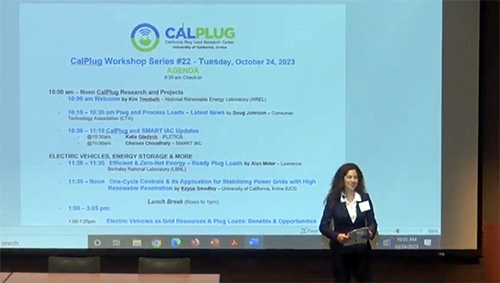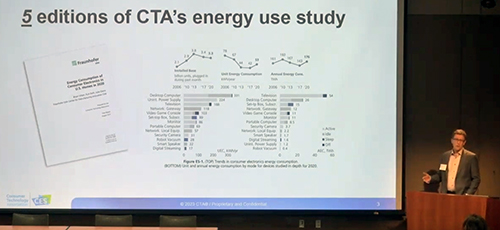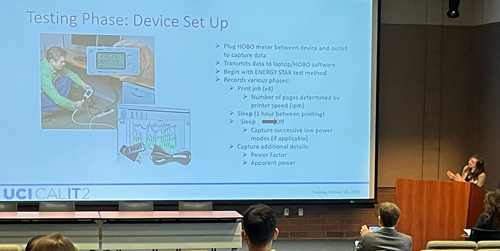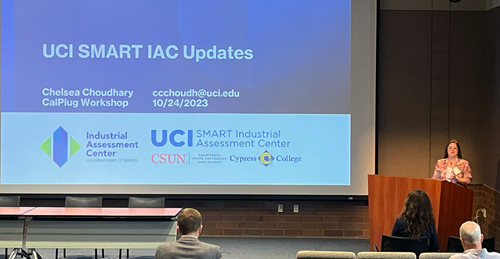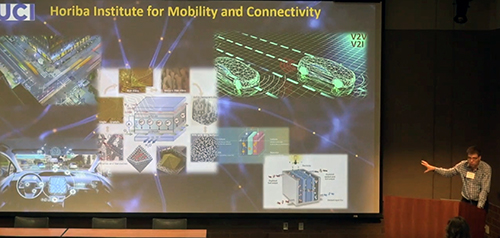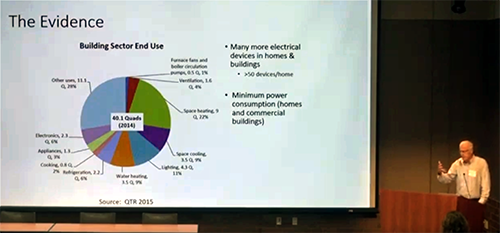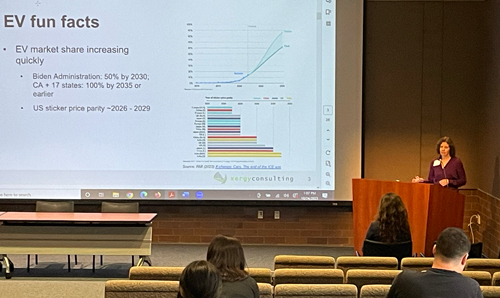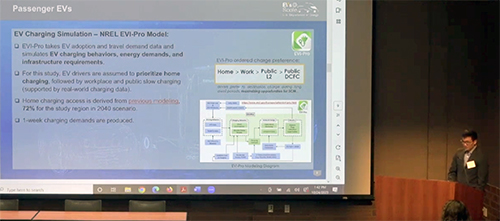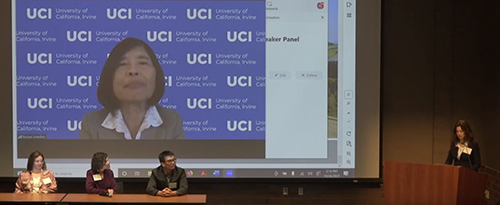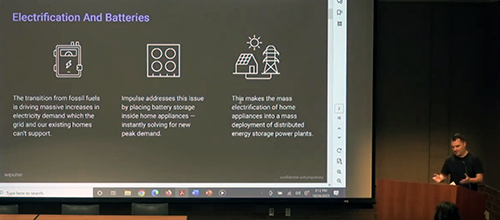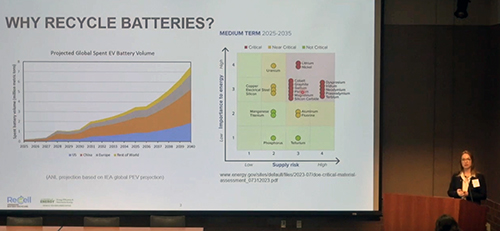Jan. 4, 2024
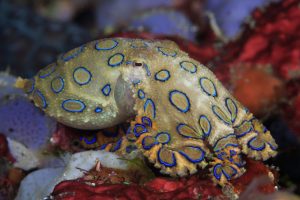
The greater blue-ringed octopus, native to waters in the Western Pacific Ocean and Indian Ocean, can ward off predators with an iridescent flash of the circular shapes on its skin. A research team led by Alon Gorodetsky, UCI professor of chemical and biomolecular engineering, drew inspiration from this amazing creature to develop a signaling and deception technology platform with a multitude of uses. Thierry Eidenweil / Getty Images
With a split-second muscle contraction, the greater blue-ringed octopus can change the size and color of the namesake patterns on its skin for purposes of deception, camouflage and signaling. Researchers at the University of California, Irvine have drawn inspiration from this natural wonder to develop a technological platform with similar capabilities for use in a variety of fields, including the military, medicine, robotics and sustainable energy.
According to its inventors, new devices made possible by this innovation will benefit from dynamically adjustable fluorescent and spectroscopic properties, ease of manufacturing, and potential for scaling to areas large enough to cover vehicles, billboards and even buildings. The bio-inspired creation is the subject of a study published recently in Nature Communications.
Hapalochlaena lunulata is a species of octopus native to the Western Pacific Ocean and Indian Ocean. It uses a neurotoxin venom to stun its prey and can ward off predators with a flash of its blue rings. These iridescent circles on a brown background on the creature’s skin are what drew the attention of the UCI researchers.
“We are fascinated by the mechanisms underpinning the blue-ringed octopus’ ability to rapidly switch its skin markings between hidden and exposed states,” said senior co-author Alon Gorodetsky, UCI professor of chemical and biomolecular engineering and CALIT2-affiliated researcher who’s Lab for Cephalopod-inspired Materials is located in the building. “For this project, we worked to mimic the octopus’ natural abilities with devices from unique materials we synthesized in our laboratory, and the result is an octopus-inspired deception and signaling system that is straightforward to fabricate, functions for a long time when operated continuously, and can even repair itself when damaged.”
The architecture of the innovation calls for a thin film consisting of wrinkled blue rings surrounding brown circles – much like those on the octopus – sandwiched between a topmost transparent proton-conducting electrode and an underlying acrylic membrane, with another identical electrode underneath.
Further technical creativity by the researchers occurs at the molecular level as they explored the use of acenes, which are organic compounds made up of linearly fused benzene rings. Designer nonacene-like molecules (with nine linearly fused rings) used by the team help give the platform some of its outstanding capabilities, according to Gorodetsky.
“For our devices, we conceptualized and designed a nonacene-like molecule with a unique architecture,” said co-lead author Preeta Pratakshya, who recently received her Ph.D. in UCI’s Department of Chemistry. “Acenes are organic hydrocarbon molecules with a host of advantageous characteristics, including ease of synthesis, tunable electronic characteristics, and controllable optical properties.”
She added, “Our nonacene-like molecules are exceptional among acenes because they can survive years of storage in air and over a day of continuous irradiation with bright light in air. No other expanded acene displays this combined long-term stability under such harsh conditions.”
According to Gorodetsky, the type of molecules used to fabricate the colored blue ring layer are what endow the devices with their most favorable features, including adjustable spectroscopic properties, the facilitation of straightforward benchtop manufacturing and ambient-atmosphere stability under illumination.
“Our co-author Sahar Sharifzadeh, a Boston University professor of electrical and computer engineering, demonstrated that the stimuli-responsive properties of the molecules can be computationally predicted, which opens paths for the in silico design of other camouflage technologies,” Gorodetsky said.
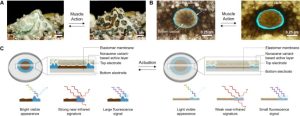
Octopus-inspired deception and signaling systems from an exceptionally stable acene variant is the subject of a paper by UC Irvine researchers published in Nature Communications.
In their laboratory tests, many of which happened in UCI’s California Institute for Telecommunications and Information Technology, the team found that the bioinspired devices could change their visible appearance over 500 times with little or no degradation, and they also could autonomously self-repair without user intervention.
The invention was demonstrated to possess a desirable combination of capabilities in the ultraviolet, visible light, and near-infrared parts of the electromagnetic spectrum, according to Gorodetsky. This would enable the devices to disguise other objects from detection or to clandestinely signal observers.
“The photophysical robustness and general processability of our nonacene-like molecule – and presumably its variants – opens opportunities for future investigation of these compounds within the context of traditional optoelectronic systems such as light-emitting diodes and solar cells,” added Gorodetsky.
Joining Gorodetsky and Pratakshya in this study were Chengyi Xu, Panyiming Liu, Reina Kurakake, and Robert Lopez in UCI’s Department of Materials Science and Engineering; David Josh Dibble and Anthony Burke in UCI’s Department of Chemical and Biomolecular Engineering; Philip Denison in UCI’s Department of Chemistry; and Aliya Mukazhanova and Sharifzadeh of Boston University. The Office of Naval Research, the Defense Advanced Research Projects Agency, and the National Science Foundation provided funding support.
– Brian Bell
Mar. 7, 2024

An atmospheric river didn’t stop registrants from attending the annual biomedical symposium in February. Participants weathered the heavy rains to spend the afternoon learning more about the Orange County biomed landscape.
The symposium kicked off with Alvin Viray, associate director at UC Irvine’s Applied Innovation, explaining the university’s commitment to OC’s startup ecosystem and collaboration opportunities that exist on campus. He was followed by Curtis Huffmire, a partner at Knobbe Martens, one of America’s largest Intellectual Property & technology law firms and longtime partner of CALIT2. Huffmire enlightened the audience with details about legal protections for medical devices and data.
The agenda then turned to four presentations from heads of OC startups in areas of biomedical devices, data and technology. After a short break, UCI innovation was on display with faculty and students giving talks and demonstrations.
The final two presentations included James Staggs, senior engineer at Johnson & Johnson, explaining the evolution of their cataract surgery systems. He was followed by Sean White, Medtronic’s director of research and technology, who discussed healthcare technology for the digital age.
The following are pdfs of most of the presentations:
O1 UCI’s Collaboration and Commitment to OC’s Startup Ecosystem
ALVIN VIRAY, Associate Director, Applied Innovation, UC Irvine
O2 Legal Protections for Medical Devices and Data
CURTIS HUFFMIRE, Partner, Knobbe Martens
03 Pathology – Transformation in the Digital Era
MOHIT KALE, CTO, PathForce Technologies Inc.
04 XR/AI Technologies Addressing Unmet Needs in Healthcare
RAJESH JHA, CEO, SIM Insights
07 Teaching Neurons—Functional Programming of Human Stem-Cell Derived Neuronal
Networks with External Cues
08 PICARD (Patient-Initiated Control Analgesic Remote Dispenser) – Biometric Bottle to
Monitor Opioid Use
09 Novel Uterine Compression Suture Technique for the Treatment of Postpartum
Hemorrhage
10 ARC (Activity Recording CAFE) – A High Throughput and Automated Behavioral Phenomic
Assessment Machine Vision
11 Evolution of J&J/AMO Cataract Surgery Systems
JAMES STAGGS, Sr Engineer, Johnson & Johnson
12 Healthcare Technology for the Digital Age
SEAN WHITE, Director of Research & Technology, Medtronic
– Shelly Nazarenus
Dec. 12, 2023
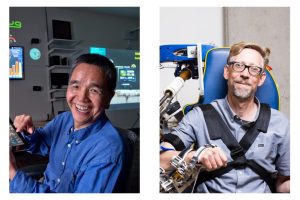
Guann-Pyng (G.P.) Li (left), UCI professor of electrical engineering and computer science, and David Reinkensmeyer, UCI professor of anatomy and neurobiology and mechanical and aerospace engineering, have been named 2023 fellows by the National Academy of Inventors for making significant contributions to science and society through their work. UCI
The National Academy of Inventors has named two University of California, Irvine researchers as fellows. Guann-Pyng (G.P.) Li, a pioneer in the development of microelectronics for advanced health and sustainable energy applications, and David Reinkensmeyer, who combines robotics and neuroscience to create devices to help people with movement rehabilitation after neurological injury, are among 162 academic inventors made fellows by the NAI this year.
“We are extremely proud of this recognition,” said Hal Stern, UCI provost and executive vice chancellor. “Professors Li and Reinkensmeyer have spent their careers at UC Irvine developing technological innovations that address critical societal needs in health, energy and the environment. Their work moving basic research into applications serves as excellent examples of the benefits of the modern research university.”
A professor of electrical engineering and computer science, Li directs the California Institute for Telecommunications and Information Technology. Founded in 2000 with California state funding, CALIT2 is a multidisciplinary research institute harnessing the ubiquity and scale of the internet and wireless technologies to accelerate growth in industry and numerous scientific fields.
In addition, Li heads CALIT2’s TechPortal technology business incubator, which supports and nurtures young companies and UCI researchers who wish to commercialize their inventions.
The holder of 40 U.S. patents, with five patents pending, he has published more than 430 research papers involving microelectronic technologies; microwave circuit design; microelectromechanical systems for communication and biomedical instrumentation applications; and biotechnology, nanotechnology, information technology, Internet of Things and data analytics for edge actionable intelligence in efficient energy utilization, smart manufacturing and e-health.
Li received an outstanding research contribution award from IBM in 1987, outstanding engineering professor awards from UCI in 1997 and 2001, the UCI Innovators Award in 2005, and the Outstanding Asian American and Pacific Islander Community Leaders and Role Models Award from the Asian Business Association of Orange County in 2009. He has been involved in several startup companies as a co-founder or technical advisory board member and is a fellow of the Institute of Electrical and Electronics Engineers and the Asia-Pacific Artificial Intelligence Association.
“I am honored to have been elected as a fellow to the National Academy of Inventors,” Li said. “To have been able to spend my time at UC Irvine applying technologies to solve real-world problems and helping others develop and commercialize their innovations has been highly rewarding.”
After coming to UCI in 1997, Reinkensmeyer established a research program to create robotic and sensor-based systems for movement training and assessment tailored to people who have experienced neurological injuries and disease. His research group relies on an understanding of neuromuscular plasticity mechanisms to develop rehabilitative technologies. This work, he said, helps people improve their movement recovery and enhances scientific knowledge about use-dependent brain plasticity.
Reinkensmeyer holds appointments in four UCI departments: mechanical and aerospace engineering, anatomy and neurobiology, biomedical engineering, and physical medicine and rehabilitation. He holds 12 patents and is a co-inventor of the T-WREX arm training exoskeleton, commercialized by Hocoma as ArmeoSpring and now in use in more than 1,500 rehabilitation facilities worldwide for people who have suffered a stroke, spinal cord damage, multiple sclerosis, cerebral palsy and orthopedic injuries. Reinkensmeyer is also co-inventor of the MusicGlove, a finger dexterity training device for stroke patients now being commercialized by Flint Rehab, a company he helped start.
He is co-director of the Collaborative Machines Enhancing Therapies Rehabilitation Engineering Research Center, co-director of the National Institutes of Health K12 Engineering Career Development Center in Movement and Rehabilitation Sciences, and editor-in-chief of the Journal of NeuroEngineering and Rehabilitation. Reinkensmeyer received the Innovator of the Year Award from The Henry Samueli School of Engineering in 2016 and UCI’s Distinguished Midcareer Faculty Research Award in 2016. He is a fellow of the American Institute for Medical and Biological Engineering.
“To be recognized as a fellow by the National Academy of Inventors is a highlight of my career,” Reinkensmeyer said. “The support I’ve received from UC Irvine during my quarter of a century at the institution and the creative energy and camaraderie I’ve experienced working with my many research group members and colleagues have helped make this honor possible.”
NAI President Paul Sanberg said: “This year’s class of NAI fellows showcases the caliber of researchers that are found within the innovation ecosystem. These individuals are making significant contributions to both science and society through their work. This new class, in conjunction with our existing fellows, is creating innovations that are driving crucial advancements across a variety of disciplines and are stimulating the global and national economy in immeasurable ways as they move these technologies from lab to marketplace. We are honored to welcome these highly regarded innovators to the academy and look forward to formally inducting them at our 2024 annual conference in the Research Triangle of North Carolina.”
UCI now has 18 National Academy of Inventors fellows and more than 680 active U.S. patents. NAI fellowship is the organization’s highest professional distinction awarded solely to academic inventors.
– Brian Bell
Nov. 27, 2023
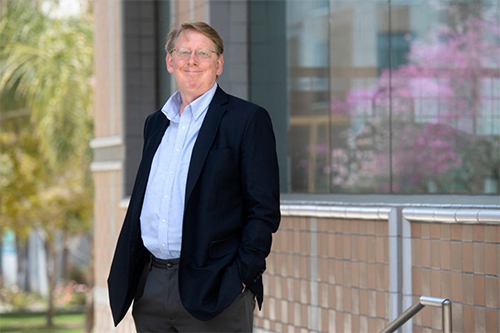
“When we first started studying isolated mitochondria, we knew they behaved like a battery based on some work from the Tokyo Metropolitan Institute of Gerontology and UCLA, but we could not control them very well inside the cell to probe them. Now we can control each individual electrical component and cause it to charge and discharge,” says Peter Burke, UCI professor of electrical engineering and computer science, co-author of a paper in ACS Nano on using super-resolution microscopes to study tiny components inside cells that are key to human health and longevity. Steve Zylius / UCI
Using new super-resolution microscopes, researchers at the University of California, Irvine and the University of Pennsylvania have for the first time observed electrical charge and discharge functions inside mitochondria isolated from cells.
A mitochondrion is a structure within a cell that uses aerobic respiration to generate adenosine triphosphate, an organic compound that provides energy to support many processes in living tissues. Medical and biomedical engineering researchers have sought greater understanding of mitochondria, recognizing their importance in human health and disease.
While many past research projects have studied the physical characteristics of these components as they exist within living cells, the UCI-led project is the first to use super-resolution microscopes to study live, extracellular mitochondria. By observing the changes in the mitochondrial membranes under different metabolic states this way, the researchers were able to witness the electrophysiological functioning of these living organelles. The team’s results were published in the journal ACS Nano.
“When we first started studying isolated mitochondria, we knew they behaved like a battery based on some work from the Tokyo Metropolitan Institute of Gerontology and UCLA, but we could not control them very well inside the cell to probe them,” said co-author Peter Burke, UCI professor of electrical engineering and computer science, and CALIT2 affiliate. “Now we can control each individual electrical component and cause it to charge and discharge.”
He said the work was made possible by a new generation of super-resolution microscopes. Team members used all three leading methods – Airy microscopy, stimulated emission depletion microscopy and lattice structured illumination microscopy – in their study.
This enabled them to examine cristae, repeating serpentine structures within mitochondria that measure about 100 nanometers. The shortest wavelength of visible light is violet at about 380 nanometers, Burke said, so they needed powerful instruments – super-resolution microscopes – to probe the voltage distribution of something less than a third of that size.
“Imagine trying to study how the battery pack in a Tesla works, but you can only do it by driving the car,” he said. “You would not learn much about the battery pack inside the car.”
By taking mitochondria out of the cell and keeping them alive, Burke and his collaborators – lead author ChiaHung Lee, UCI graduate student researcher in biomedical engineering, and Douglas Wallace of the University of Pennsylvania – were able to charge and discharge them.
“We could observe in detail how each individual part behaved as a single battery, much like how battery packs in drones and cars – which are many smaller batteries – individually combine to power the vehicle,” Burke said. “Interestingly, we found that the batteries rearrange themselves when they charge and discharge, a feature not found in regular batteries.”
He noted that his experiments proved what researchers had long thought while studying snapshots of frozen (dead) mitochondria: The internal structure changes in response to the metabolic needs of the cell. A mitochondrion can create and destroy its “batteries” (cristae) as needed. This shows that, unlike drones and Teslas, mitochondria can alter their internal shapes based on how much energy is needed by cells.
Burke said this work could have broad applications in human health, including studies on how humans age at the cellular level.
“Once we understand how they create energy, we can start to think of ways to modify this for improving human health and longevity,” he said.
The project was funded by the National Institutes of Health and the Army Research Office.
– Brian Bell
Nov. 6, 2023
On Oct. 24, CalPlug hosted their semi-annual workshop at CALIT2. The event focused on batteries as a device, as a plug load, and as storage in relation to energy efficiency and renewable energy.
The CalPlug workshop series was launched in 2011 with the goal to maximize communication of the latest research findings and development, and to address challenges in plug load efficiency for both residential and commercial buildings. The events bring together utilities, manufacturers, advocacy groups, research institutions and energy policymakers.
Morning sessions featured a welcome from Kim Trenbath, National Renewable Energy Laboratory (NREL), updates by CalPlug and SMART IAC, and sessions about electric vehicles and energy storage.
Afternoon sessions centered on topics including, “Artificial Intelligence for Electric Vehicle Fleets” and “Electric Vehicles as Grid Resources and Plug Loads: Benefits and Opportunities” The program concluded with a panel discussion on energy storage and Q&A with the guest speakers, followed by a network reception in the CALIT2 atrium.
Videos and presentation PDFs can be viewed below.
Click images below to view video presentations.
Kim Trenbath, National Renewable Energy Laboratory (NREL)
“Welcome”
Doug Johnson, Consumer Technology Association (CTA)
“Plug and Process Loads – Latest News”
Katie Gladych, CalPlug
“Plug Load Energy Testing to Inform Codes and Standards (PLETICS) & Low Power Mode”
Chelsea Choudhary, Sustainable Manufacturing Alliance for Research and Training Industrial Assessment Center (SMART IAC)
“UCI SMART IAC Updates”
Dominik Haering, HORIBA Institute for Mobility and Connectivity (HIMaC)
“An Overview of Capabilities and Possibilities at HIMaC”
Alan Meier, Lawrence Berkeley National Laboratory
“Efficient and ZNE-Ready Plug Loads CPR Meeting”
Keyue Smedley, Dept. of Electrical Engineering & Computer Sciences, UC Irvine
“One-Cycle Controls and Its Application for Stabilizing Power Grids with High Renewable Penetration”
Katherine Dayem, Xergy Consulting
“Electric Vehicles as Grid Resources and Plug Loads: Benefits and Opportunities”
Zhaocai Liu, National Renewable Energy Laboratory (NREL)
“Transportation Network Modeling & Infrastructure Planning”
Panel discussion on EVs by guest speakers
Choudhary, Dayem, Liu, Smedley
Sam D’Amico, Impulse Labs
“Driving Electrification with Integrated Batteries”
Eva Allen, Argonne National Laboratory (ANL)
“ReCell: Working to Advancing Battery Recycling”
Panel discussion on energy storage by guest speakers
Johnson, Meier, D’Amico, Allen, Gladych
– Sharon Henry
Nov. 6, 2023

The tiny device with five microelectrodes was fabricated in UCI’s Integrated Nanosystems Research Facility.
UC Irvine engineering researchers have developed a novel micro biosensor that could help neuroscientists investigate and better understand normal brain functions and disorders such as autism, brain injury and stroke.
“This is the first showcase of a dual L-glutamate/GABBA implantable microsensor, which can help transform the field of brain research in many aspects,” said Hung Cao, UCI associate professor of electrical engineering. “This tool is a dream for neuroscientists.”
The tiny device has a shaft with five microelectrodes (50 microns by 100 microns each) at the tip, that can be inserted anywhere into gray matter to successfully detect the two major neurotransmitters that govern excitation and inhibition, namely L-glutamate and gamma-aminobutyric acid (GABA), respectively. These two neurotransmitters govern nearly all processes in the brain, from birth to death.
The research team, led by Cao and his former biomedical engineering doctoral student Sung Sik Chu, validated the sensor in animal models and published their findings in Biosensors and Bioelectronics.
An imbalance of excitation/inhibition ratios are associated with a variety of neurological disorders, making accurate monitoring of these neurotransmitter levels crucial for investigating underlying causes of these conditions.
“We targeted both neurotransmitters simultaneously and in real time so we can actually see the levels and see how any changes in balance can be related to neurological disorders,” said Chu.
With funding from the National Science Foundation, the team has been working on this sensor for the past three years. Chu spent many hours in the Samueli School’s Integrated Nanosystems Research Facility (INRF) fabricating batches of microprobes, which required advanced equipment in clean rooms and fine-tuning materials to achieve a flexible, biocompatible and highly sensitive sensor.
The dual neurotransmitter sensor probe was validated under various settings for its performance. “Overall, our dual L-glutamate/GABA sensor microprobe has unique features to enable accurate, real-time, and long-term monitoring and it should aid investigations of many brain processes,” said Cao.
He plans to continue fine-tuning the sensor, making it smaller and wireless, and hopes to offer it to others on campus who are researching brain injury, stroke and other neurological disorders.
– Lori Brandt
Oct. 6, 2023
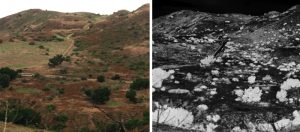
Measuring vegetation health
The left image is a Loma Ridge scene captured by the hyperspectral camera. The image on the right represents vegetation health at each pixel by image brightness. Pixels that are the brightest represent the healthiest vegetation.
In a pioneering climate change experiment, UC Irvine researchers have been studying a five-acre area on Loma Ridge, near the Limestone Canyon Preserve, northeast of Irvine. The project aims to gain a better understanding of Southern California’s ecosystems’ sensitivity to various environmental shifts, primarily how changes in water and nitrogen levels impact the nearby grasslands and shrublands.
A Quest for Understanding
Initiated in 2006 by Mike Goulden, a professor of earth system science at UCI, the experiment incorporates a meticulously designed study plan. It encompasses three distinct tiers of water input: ambient conditions, drought conditions (about 40% less than the actual rainfall amount), and wet conditions (about 30% more than the actual rainfall amount). Especially in recent years, Southern California has experienced erratic rainfall patterns, alternating between exceptionally dry years and those with more rainfall than usual.
One question driving this research is the impact of severe drought conditions on California’s ecosystems. To simulate drought, the team employs specialized structures that shield the experimental plots from rainfall during storms, effectively creating arid conditions. This controlled setup allows researchers to closely examine how native plants respond to reduced water availability, providing valuable insights into the resilience of the region’s vegetation.
While drought plays a role in altering vegetation, it’s not the sole factor, says Steven Allison, a professor of ecology & evolutionary biology in the UCI School of Biological Sciences. Elements such as nitrogen levels, microbial communities, and the frequency of extreme precipitation events all contribute to the complex dynamics observed in these ecosystems. This knowledge holds the key to predicting and mitigating the effects of climate change on these landscapes by offering insights into which plants may succumb to drought and which may possess the resilience to recover.
Computer Vision Meets Ecology
The project recently began a collaboration with researchers from the Computer Vision Laboratory (CVL) at CALIT2. CVL specializes in hyperspectral and multispectral image modeling and automated analysis, offering a unique perspective on the experiment.
Traditional methods of ecological observation can be labor-intensive. Researchers equipped with detectors must painstakingly measure variables like carbon movement through leaves or the rate of photosynthesis, often on a leaf-by-leaf or plant-by-plant basis.
In contrast, the CVL team employs sensors that can view a large area of the landscape in an instant which allows computer algorithms to analyze the physiological state of the plants over a region in seconds. Their objective is to detect signs of stress in the vegetation. By capturing data at the scale of the entire ecosystem and encompassing different plant species, they generate a wealth of information that can uncover variability patterns and potentially forecast future ecological shifts.
Led by Glenn Healey, CVL’s director and a professor in electrical engineering and computer science at UCI, the team leverages the power of hyperspectral imaging which utilizes cameras capable of discerning many more colors than traditional cameras or the human eye. Their approach involves using these sensors to capture a series of scans of the ridge. These scans create a rich dataset that provides unparalleled insights into the state of the ecosystem.
“We recently collected data at Loma Ridge with a team from CVL, researchers from UCI’s School of Biological Sciences, and a group from CALIT2 at UCSD,” Healey explains. “The outcome is a large set of data collected using hyperspectral, LiDAR, and photogrammetry instruments from both the ground and the air. We plan to use this data for the automated identification of different types of plants and to measure their health and to gauge air quality.”
A Story of Resilience
The experiment has encountered its share of challenges. In 2007, the Santiago fire ravaged the site, effectively resetting the entire ecosystem. Following such disturbances, ecosystems undergo a process known as ecological succession. Fast-growing weeds initially emerge, followed by slower growers that ultimately dominate the landscape.
In 2020, the Silverado fire—another uncontrolled burn—swept through the research site. The blaze revealed an unexpected outcome. The arid plots experienced less intense burning due to a lack of fuel from drought-stunted shrubs, creating an opportunity for invasive grasses to thrive. The once-sage-scrub-habitat now faced the potential of becoming a permanent grassland.
This is a problem because grasses tend to grow back rapidly and are highly flammable, explains Allison. “The more fires we have, the more grass there is, and more grass leads to more fires.” This cycle transforms the native shrub lands into invasive grasslands. Grasslands also provide lower-quality habitat to support numerous endangered and threatened wildlife species, notes Allison.
The loss of this habitat is primarily due to development – freeways, housing and shopping centers have encroached on wildlife habitats, bringing with them greater risks from drought, wildfires and invasive plant species. Currently, the site is managed by the Irvine Ranch Conservancy, whose primary goal is to protect the ecological health of urban wildlands.
Loma Ridge is located on the ancestral lands of the Tongva and Acjachemen tribes who have long-term, ongoing cultural ties to the area. The Acjachemen use native grasses and other plants for a variety of cultural purposes. Native grasses coexist with native wildflowers, growing in tall clumps with deeper roots. “The original, native California grasslands must have been incredibly beautiful,” says Allison. “But now, all we see are wild oats, brown grass, and mustard, which are species from the Mediterranean region of Europe and were introduced by Spanish colonists.”
The research raises critical questions about the future of California’s iconic landscapes. Will the ongoing drought and climate change permanently shift these ecosystems towards a grassland-dominated state? Can native shrubs recover if rainfall patterns return to normal? These are questions with far-reaching implications for biodiversity, habitat quality, and California’s ability to adapt to a changing climate. By gaining a deeper understanding of the complex interactions of environmental drivers, solutions can be offered to safeguard California’s iconic landscapes and ensure their resilience.
– Sharon Henry
Sept. 20, 2023
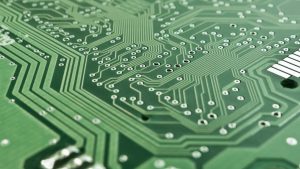 Deputy Secretary of Defense Kathleen Hicks on Wednesday announced the award of $238 million in Creating Helpful Incentives to Produce Semiconductors (CHIPS) and Science Act funding for the establishment of eight Microelectronics Commons regional innovation hubs. This is the largest award to date under the CHIPS and Science Act.
Deputy Secretary of Defense Kathleen Hicks on Wednesday announced the award of $238 million in Creating Helpful Incentives to Produce Semiconductors (CHIPS) and Science Act funding for the establishment of eight Microelectronics Commons regional innovation hubs. This is the largest award to date under the CHIPS and Science Act.
USC was named one of the hub leaders for the Microelectronics Commons program. USC is working with 15 other institutions.
“Our united effort will tackle everything from cybersecurity and blockchain to next-generation medical treatments and climate change,” USC President Carol L. Folt said. “It’s USC’s privilege to be leading and collaborating with the powerhouse research universities and industry in Southern California, addressing national security, helping solve global problems, bringing major technological advances and jobs to our region, and ensuring U.S. economic growth.”
The superhub at USC is led by researcher Stephen Crago of USC Viterbi’s Information Sciences Institute and the school’s Ming Hsieh Department of Electrical Engineering. The USC-led hub involves:
• The Boeing Co.
• Caltech
• HRL Laboratories
• Lockheed Martin Aeronautics
• Morgan State University, Baltimore
• North Carolina Agricultural and Technical University, Greensboro, N.C.
• Northrop Grumman Corp.
• Pasadena City College
• PDF Solutions
• Raytheon Co.
• Teledyne Technologies
• University of California, Irvine
• UCLA
• University of California, Riverside
• University of California, San Diego
• University of California, Santa Barbara
Learn more on the Department of Defense website.
– USC Staff
Sept. 13, 2023
CALIT2’s MADO (Making a Difference Opportunity) program has announced its student projects for 2024. The diverse array of projects provides a unique opportunity for full-time UCI students to gain valuable workplace experience by collaborating on short-term (5-month) projects with local businesses.
Key goals of the MADO program include:
Transition to the Job Market: By gaining practical experience, MADO participants are better prepared to transition seamlessly into the job market upon graduation.
Workforce Development: Local businesses can engage with emerging talents and actively contribute to workforce development.
Societal Impact: MADO projects are designed to have a positive impact on society, addressing pressing challenges in various domains.
Projects scheduled for 2024 encompass a diverse range of fields – from digital marketing to data analysis and Artificial Intelligence (AI).
To review upcoming project visit: https://www.calit2.uci.edu/mado/mado-projects/
For more information about CALIT2’s Making a Difference Opportunity (MADO) program, visit https://www.calit2.uci.edu/mado/
– Sharon Henry
Sept. 13, 2023
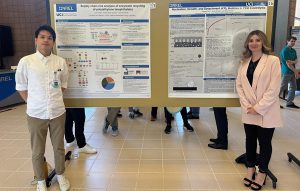
SMART IAC (Industrial Assessment Center) summer interns, John Pham, chemical engineering major and Daniela Ruiz, mechanical engineering, PhD student, presented findings from their research projects at the National Renewable Energy Laboratory (NREL) Intern Symposium on July 31 in Golden, Colorado.
Pham’s research on supply chain risk analysis in enzymatic recycling has significant implications for sustainable waste management and plastic recycling. Ruiz’s work on understanding the behavior of oxygen bubbles in PEM electrolysis holds promise for advancing clean energy technologies.
The internship program with NREL is sponsored by UCI SMART IAC program to support two research-based internship opportunities at NREL each year. Students work on site at the laboratory in Colorado over the summer and gain valuable hands-on research experience, while being mentored by real-world scientists and researchers. Students can apply their theoretical classwork to research projects and observe how a research lab operates.
“While at NREL, Daniela and John represented not only the SMART IAC program, but also UCI as a whole very professionally and we’ve received great feedback from the NREL mentorship team regarding our student’s dedication and work ethic. I am so proud of both Daniela and John for their accomplishments this summer,” says Chelsea Choudhary, program manager, SMART IAC.
NREL is a national laboratory of the U.S. Department of Energy. It is the only federal laboratory dedicated to research, development, commercialization, and deployment of renewable energy and energy efficiency technologies.
For more information about SMART IAC, visit https://smartiac.calit2.uci.edu/
– Sharon Henry
© CALIT2, University of California, Irvine 2020

